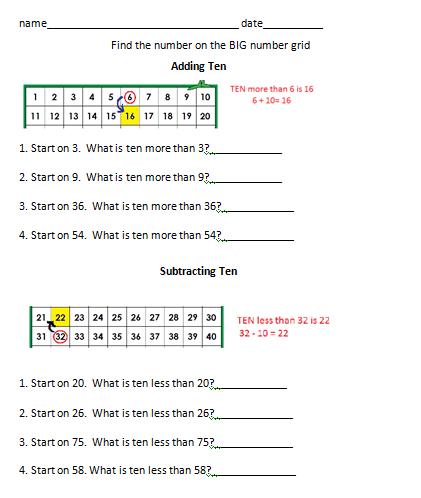I made this worksheet today as well! For years and years we have been teaching our students to add vertically, however, students rarely understand why. When children add vertically are they truly understanding they are adding tens and ones? I don't think they really are. I think students are just learning... ok to add numbers vertically I just add down. So they would look at 36+3 as...
From perhaps at least ONE student's perspective:
36
+ 3
OK my teacher tells me I add down...
1. lets add 6+3=9
2. ok lets move over to the left
3. lets add 3+0= 3
4. The answer is bring down the 9 and bring down the 3.. 39
However how can we truly know as educators if the student memorized the pattern of adding down or if he or she truly understands that the "3" they added to "0" is really "30" + 0 (tens) = 30
Cross Number Puzzles SHOWS PLACE VALUE!
The creative classroom! Ideas, lessons, love!
Monday, December 3, 2012
Adding and Subtracting by 10
I created this worksheet for one of my classes I teach. They needed help adding and subtracting by 10 on the number-line.
Vowels and Consonants- EZ to remember!
I made this worksheet today to help my students remember their letters. This makes it visually easier to see that "V' is for vowels and "C" is for consonants!
Running Record Scoring
For teachers that need help with RUNNING RECORDS
Error Rate
Error rate is expressed as a ratio and is calculated by using the following formula:
Total words / Total errors = Error rate
Example:
99 / 8 = 12.38, or 12 rounded to nearest whole number
The ratio is expressed as 1:12.
This means that for each error made, the student read approximately 12 words correctly.
Accuracy Rate
Accuracy rate is expressed as a percentage. You can calculate the accuracy rate using the following formula:
(Total words read – Total errors) / Total words read x 100 = Accuracy rate
Example:
(99 – 8) / 99 x 100 = Accuracy rate
91/99 x 100 = Accuracy rate
.919 x 100 = 91.9%, or 92% rounded to the nearest whole number
You can use accuracy rate to determine whether the text read is easy enough for independent reading, appropriate to use without frustration during reading instruction purposes instruction, or too difficult for the reader. The breakdown of these three categories is as follows:
Easy enough for independent reading = 95 – 100%
Instructional level for use in leveled reading session = 90 – 94%
Too difficult and will frustrate the reader = 89% and below
Self-Correction Rate
Self-correction rate is expressed as a ratio and is calculated by using the following formula:
(Number of errors + Number of self corrections) / Number of self corrections = Self-correction rate
Example:
(8 + 3) / 3 = Self-correction rate
11 / 3 = 3.666, or 4 rounded to the nearest whole number
The self-correction rate is expressed as 1:4. This means that the student corrects approximately 1 out of every 4 errors.
If a student is self-correcting at a rate of 1:4 or less, this indicates that she/he is self-monitoring her/his reading.
Subscribe to:
Comments (Atom)



